 |
AIN |
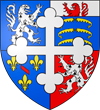 |
 Exterior view; the monastic buildings, now housing the museum, are to the right of the photograph |
Bourg-en-Bresse The Monastère Royal de Brou |
 View from the west looking down the nave; the monuments are in the chancel beyond the screen. The was a rather good Leggo exhibition in the nave. |
| The church is no
longer a parish church, nor is it a working monastery; see the history below. The entrance fee is €9.50 per person, but
this is for the whole day, that is, you may return after the
lunch break of one and half hours when the building is closed,
without buying another ticket.
The ticket also includes entry to the museum and art gallery. The church is open every day except from 9.00 am until 12.30 and 2.00 p.m. until 6.00 pm, except January 1st, May 1st, November 1st, November 11th, and December 25th (the major French jours fériés [public holidays] equivalent to British 'bank holidays'). There is plenty of free parking in the surrounding area. Photography is permitted and there is no extra charge. -1 46° 11.88' N 5° 14.20' E |
| A Brief History of the Monastery of Brou |
|
Her daughter-in-law, Margaret of Austria, herself took on this vow although this project had only just begun when she finally left for the Netherlands in 1506. She had arranged to have the parish church transferred to Notre Dame in Bourg itself and obtained permission from Pope Julius II to replace the Benedictine Monks by Augustinian Canons. She also planned for the new church to house the tomb of her late husband, Philibert, and his mother Margaret. The first stone was laid in 1506 with Margaret present. The Monastery of Brou did not reach its current size until Margaret had been named Regent of the Netherlands. In 1509 she planned that the church should eventually house her tomb as well as those of her late husband and mother-in-law and in 1512 recruited the master mason and other artisans from Brussels to construct the church, the monastic buildings and monuments; this project was finally complete in 1532, two years after Margaret's death. The church was dedicated to St. Nicholas of Tolentino, whose feast day was on the anniversary of Philibert's death. The Canons left in 1791as a result of the policies the Revolution but the monastery was spared destruction by one Thomas Riboud (a politician and magistrate) who drew the attention of the authorities to the fact that the monastery was a national monument and should be preserved by the state. Nevertheless Brou lost its bell tower and served as a prison for a period until 1823 when it again became church property acting the Diocesan Seminary. The Monastery became a Cultural Heritage Site in the 20th century and, as because of the official separation of church and stand in 1905, the Seminary moved from Brou. The site was opened to visitors a few years later. In the 1920's two museums from the city of Bourg-en-Bresse were moved to this former monastery and became jointly known as the Musée de L'Ain; now the Musée de Brou. Photographs cannot really do justice to
these three magnificent monuments; you really need to see them
and walk around them yourself. I have attempted to give an
overall representation by photographing them from several angles.
Fortunately we could enter galleries above the chancel and
take photograph from above. Some angles were not successful
because of the bright window light in certain situations
making the extreme contrast of the monuments impossible to
capture. I should also have liked to take individual photographs
of the statuary around the monuments but for reasons explained
below did not have time to do so.
|
| The Monument - An Overview |
The three monuments, all in a north-south line across the chancel are of black and white marble and alabaster and were commissioned by Margaret of Austria (see below). They were originally intended to have been designed by the famous French sculptor, Michel Colombe, and executed by his nephew. However Margaret employed a Brussels architect, Lodewijk van Boghem, to oversee the work. Under the latter's instructions, Jan van Roome (also known as Jean de Bruxelles) produced the drawings by 1516. The work was probably carried out by a Brabant workshop and completed around 1522. The three actual effigies were commissioned from the German, Conrat Meit, who was Margaret's official sculptor at her court in Mechelen. His brother, Thomas, worked with him, aided with the Italians, Onoffrio Campitoglio and Gilles Vambelli. The also probably worked on the putti and the statuettes. The three coffin still lie in their original place in a vault under Philibert's monument. |
| Philibert II 'The
Fair' (1480 - 1504) Duke of Savoy |
Philibert II, 'The Fair', Duke of Savoy was born in 1480, the son of Philip II, Duke of Savoy and Margaret of Bourbon. He inherited the Dukedom on the death of his father in 1497 and married Margaret of Austria in 1501 but died in 1504, possibly of pneumonia. There appears to be no children of this marriage. |
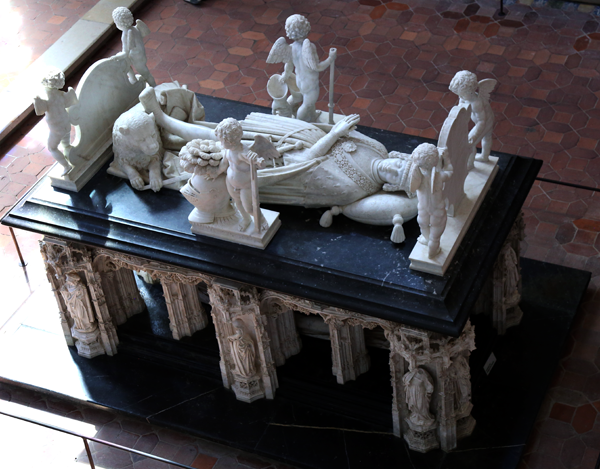 |
 |
 |
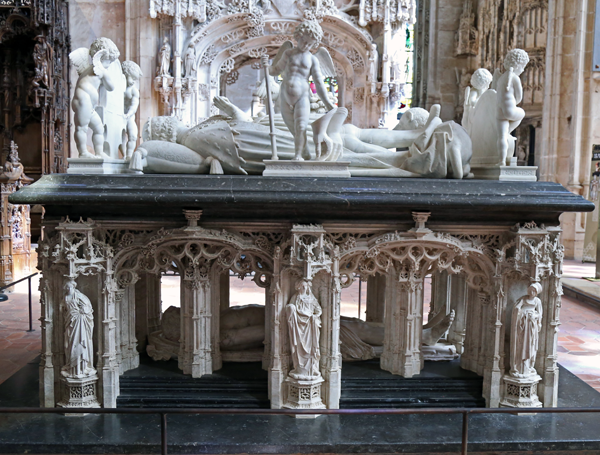 |
|
The lower stage of the
monument holds the effigy of Philibert as a cadaver (a
transi), his body being shown nearly naked. Outer and inner rows
of complex pilasters support the upper stage on which lies
Philbert's effigy in his finery, looking at his wife. In niches
in the outer rows are eight standing female figures, Virtues or
Sibyls. |
|
 |
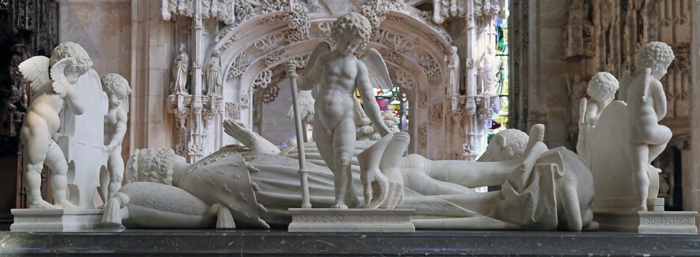 |
|
Effigy and putti from the north. Philbert's effigy looks toward
the observer and Margaret of Austria. The putti at the head hold a shield of arms carved on both sides, those at the feet a plain slab. The facing putto holds of Philibert's helmet and axe (?), parts of his parade armour |
Effigy and putti from the south. Here we can see Philibert
turned to look at his wife. The facing putto holds gloves and a staff, further parts of his armour. |
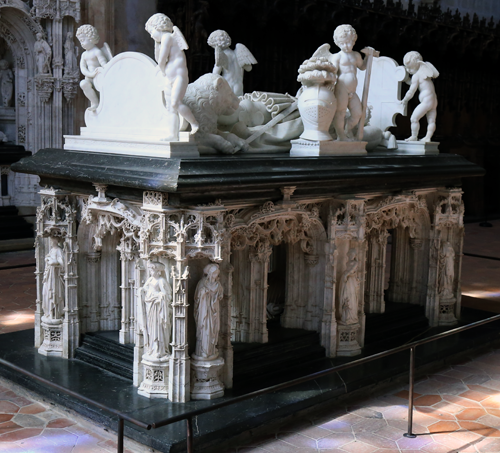 |
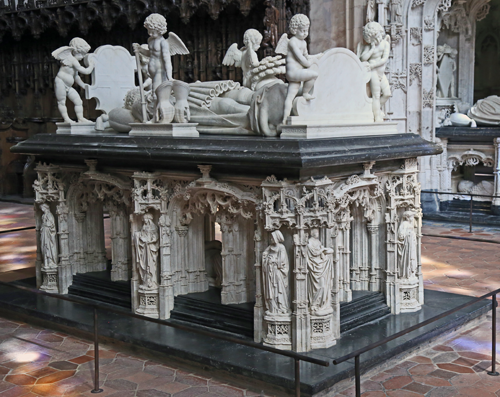 |
|
Above left: Monument from the
south-east corner, and, above right, from the north-east
corner Below left: From the north-west corner, and, below right: from the south-west corner |
|
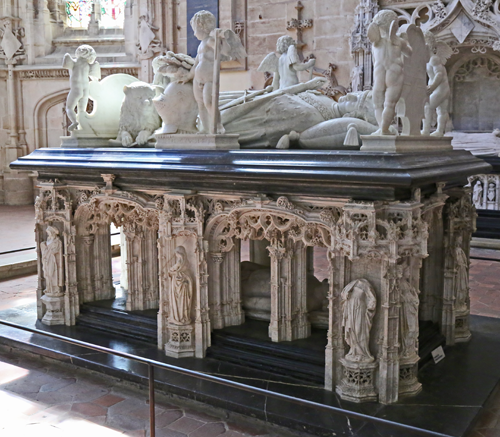 |
 |
 |
 |
 |
 |
| From left to right above: 1. The monument from the east with the two putti. In the lower stage Philbert's feet can just be seen. 2. & 3. The two putti holding pieces of parade armour. 4. The upper stage from the west with the two putti hold Philibert's arms. |
 |
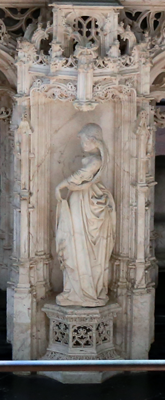 |
| Above: Philbert's effigy
(detail) Left: One of the Virtues or Sibyls |
| Margaret of Austria (1480 - 1530) | |
Margaret of Austria, born in 1480, was the daughter of Maximilian I of Austria, later to be elected Holy Roman Emperor, and Mary of Burgundy. Mary herself was the daughter of the last of the Valois Dukes of Burgundy, Charles the Rash, who had been killed at the Battle of Nancy in 1477. King Louis XI annexed Burgundy on the death of Charles so Mary became only titular Duchess of Burgundy. She did inherit Charles's other possessions, namely, the Burgundian Netherlands and the Franche-Comté, then still a fief of the Holy Roman Empire. Before Margaret was three, she was betrothed to the Dauphin Charles (the future Charles VIII) and raised at the French court, her education being supervised by the late king's (Louis XI) capable sister, Anne of Beaujeu, who acted as regent during the minority of Charles VIII. Duchess Anne of Brittany had been married by proxy at the age of thirteen to the above Maximilian of Austria, who in due course was to become Margaret's father. King Charles VII seeing that Anne's marriage to Maximilian would leave France surrounded by enemies, repudiated Margaret, invaded Brittany, captured Anne, and carried her back to France to marry her. Maximilian, involved with affairs in his own domain, did nothing to prevent this action by the French king. The legality of the marriage of Charles VIII and Anne is questionable. Margaret returned to Flanders and to her father Maximilian in 1493. She next married Juan of Castile in 1495, but this marriage was short lived, Juan dying in 1498. Margaret had given birth to a daughter but the child died within hours. In 1500 she again returned to Flanders, this time as a widow rather than a rejected 'fiancée'. In 1501 she married Philibert II, Duke of Savoy but again the marriage was short lived Philibert dying four years later, possibly of pneumonia. There appears to have been no children of this marriage and Margaret did not subsequently remarry. Following the death of his son, Philip the Fair (who had married Joanne the Mad of Aragon), in 1506, Maximilian named Margaret Regent of the Netherlands until his grandson became of age. Margaret then left the Duchy of Savoy to take up her new post. In 1530 she died and was initially buried at Bruges, where both her mother, Mary of Burgundy and her grandfather, Charles the Rash had been interred. Her body is transferred to Brou when the work on the church and monuments was completed. |
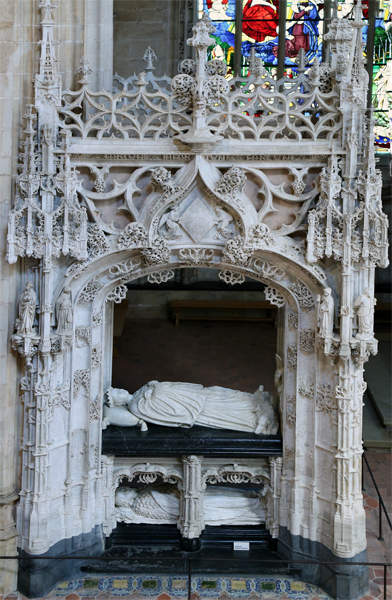 |
 Left: The monument from the chancel. Note Margaret's motto on the cornice: Fortune Infortune Fort Une (Fortune demands much of a woman.) The outer statuette on the left is of St. Catherine, trampling a dragon. Above: The two lower stages, with an effigy of Margaret in each. Above she is shown in wordly finery with her long hair dressed and below as a corpse with her long hair loose. The effigies are shown in close up below. |
  |
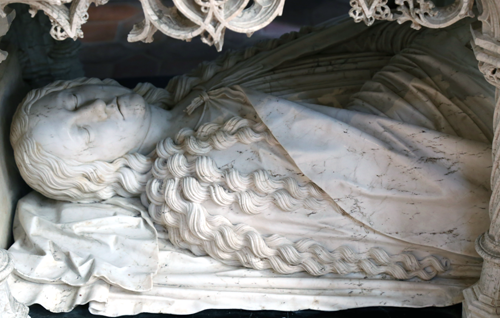  |
 |
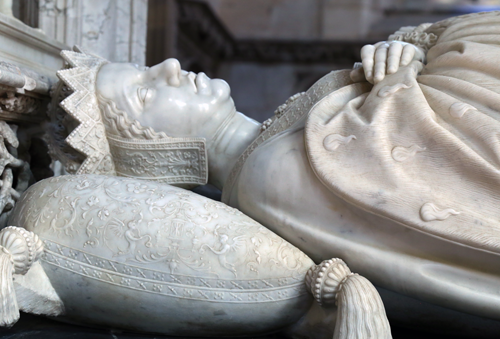 Above: Margaret's profile, dressed in her finery Left: Two putti hold a plain slab. Right: Two slightly older putti at head holding a lozenge with her arms, and a crown. Note: widows bear the combined arms of her late husband and herself: the Cross of Savoy on the heraldic dexter and Margaret's more complex arms on the sinister. |
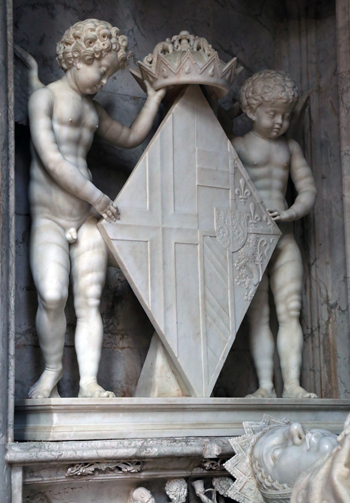 |
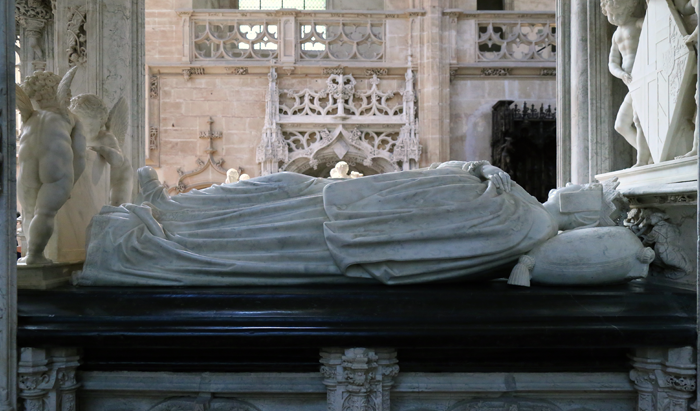 |
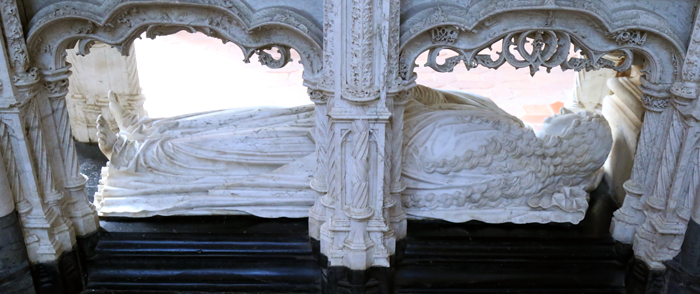 Above and left: Margaret's two effigies from the chapel to the north. It shows her turned slightly towards the chancel, looking at her husband, Philibert. Two pairs of putti may be seen: one pair at her head holding her arms on a lozenge and the other, at her feet, holding a plain slab. Details of the cadaver effigies are shown below |
 |
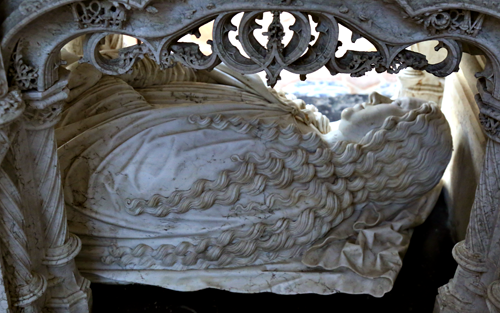 |
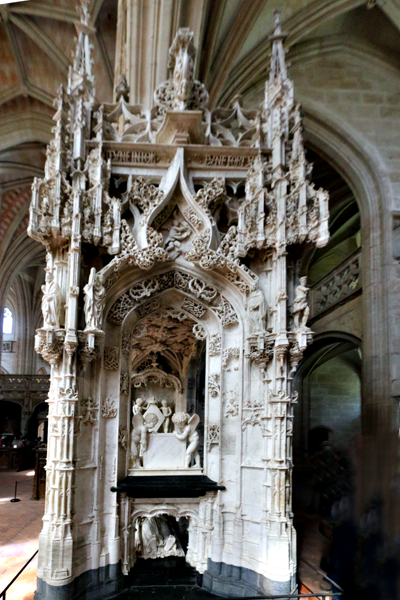 |
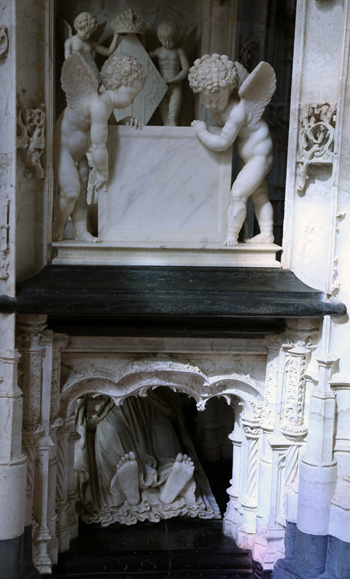 |
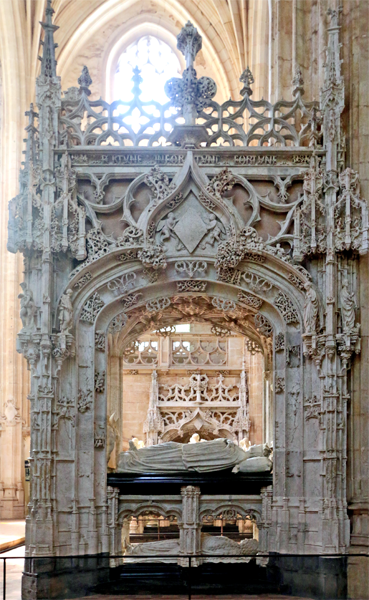 |
| Margaret's monument from the east. | Details of the monument from the east showing the putti and Margaret's bare feet |
The monument from the north chapel. looking south with the other monuments just discernable in the background |
| Margaret of Bourbon (1438 - 1483) Duchess of Savoie |
Margaret of Bourbon was born in 1438, the daughter of Charles I, Duke of Bourbon, and Agnes of Burgundy. She married Philip II, Duke of Savoy (1463-1497) in 1472. Their son was Phillibert II 'The Fair', Duke of Bourbon, born in 1480. She died in 1483. |
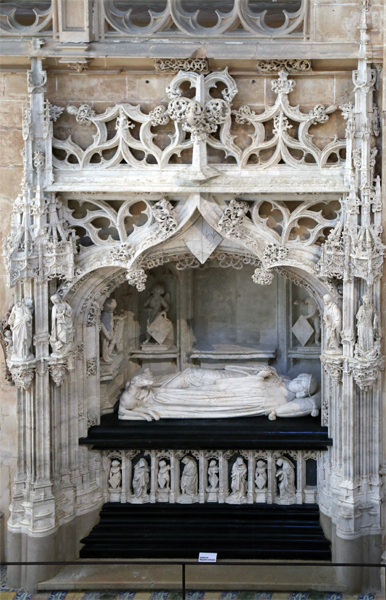 Above: The whole monument. Right top: Margaret's effigy dressed is her finery, head on a pillow, feet on a dog. There is no cadaver effigy associated with this monument. Right below: The effigy with tomb chest. Note the series of weepers: four putti holding lozenges of arms and four hooded figures. |
 |
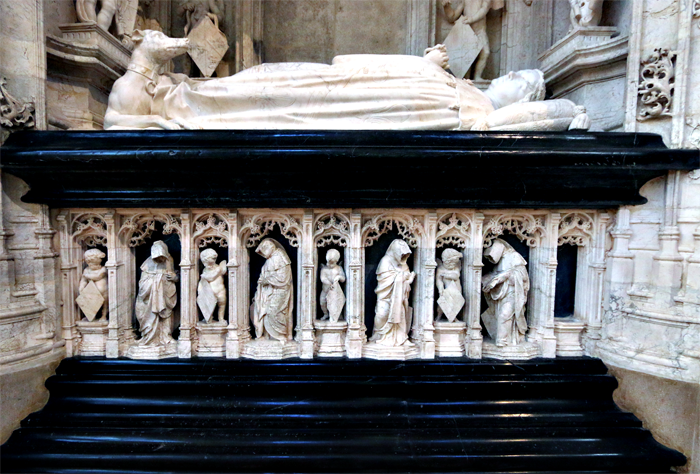 |
  |
 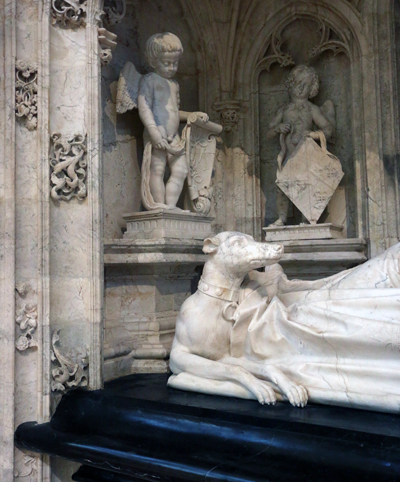 Above top: Two putti at her head hold a shield with the monogram - P and M, and a lozenge with her arms. Note the arms near the apex of the arch, which can be seen more clearly: on the heraldic dexter side are her husband's arms of Savoy impaled on the sinister with Margaret own arms. Above bottom: Two putti at her feet hold similar articles |
|
Left top: Margaret turns slightly toward the
observer and towards her son's monument. Left bottom: A close up of the monument. The inner statuette on the left is of St. Margaret. The inner on the right is of St. Andrew, and the outer St. Catherine again. |
|
| Chronology | |||||||||||||||||||||||||||||||||||||||||||||||||||||||||||||
|
|
||||||||||||||||||||||||||||||||||||||||||||||||||||||||||||
| Photography - Important |
Photography in the church of the Monastère Royal de Brou is not only allowed but there is not extra charge for taking photographs, as was mentioned in the introduction. This appears to be the usual situation in the vast majority of French churches and other similar monuments. I am uncertain about the use of flash here, which is occasionally not allowed (with good reason) in certain situations. The staff in the church are very polite and do not bother photographers. These beautiful monuments are a delight (as well as being something of a challenge) to photograph. However, there is some difficulty in attempting to take photographs in the church. The buildings are open every day from 9.00 am until 6.00 pm, except January 1st, May 1st, November 1st, November 11th, and December 25th (the major French jours fériés [public holidays] equivalent to British 'bank holidays'), but close for lunch, from 12.30 pm until 2.00 pm. These hours should cause little problem but there are official guided tours as well as school tours to contend with: there were two of each during the morning I spent there. The guides, both official and unofficial, are very long winded and spend considerable time around each monument in turn (as well as the altar and stained glass) discussing each in great detail. Their parties spread out around each monument, making photography impossible. In between these tours are many other visitors who wander around at random, again making photography difficult. You need more patience than a wild life photographer and a more quick action than a sports photographer! The best plan is the arrive as early, go for a walk during the tours, and stay as late as possible. The former monastic buildings contain a museum and art gallery; the former is very well laid out indeed while the latter houses the usual range of art works, including some contemporary 'art'. Unfortunately some of the staff here are officious and far from friendly). |
 |
Ambronay Abbey |
 |
| The Abbey was once the mother church of the priory at Brou, see above. It is no longer monastic but it is a working parish church, with the priest (2021) - a delightful man whom it was refreshing to meet after the officious attitude of some of the staff at Brou - living on the premises. It also acts as a 'cultural centre' with occasional music festivals. There is a shop - selling books, cards, bamboo straws now that those who have nothing better to do having brought about the banning of plastic ones - but there is no charge to enter the abbey. A really wonderful, peaceful place, with none of the feeling of commercialism and crowds of Brou. |
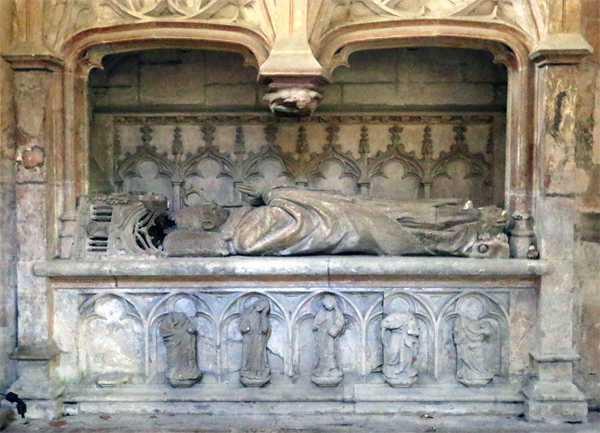 |
 |
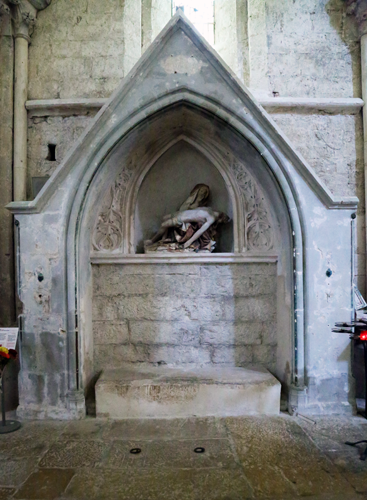 |
 |
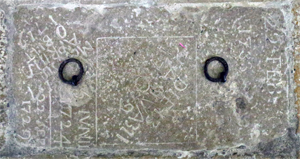 |
| Left top and centre: Abbot Jacques de Mauvoisin (1437) Note that he wears a mitre and carries a crosier. The episcopal insignia were granted by the anti-pope Benedict XIII to the abbots of Ambronay. Right top: Chapel of the Pietá. On the floor is a thick slab (also shown left bottom), said to be the entrance to the monks' burial vault. I cannot make out the details. Left bottom: In front of the aforementioned slab is this vault entrance with 18th century dates incised on the floor slab. |
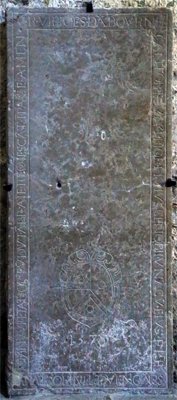 |
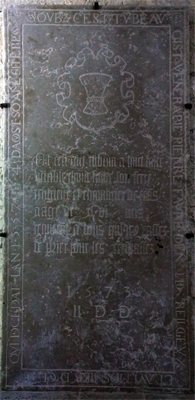 |
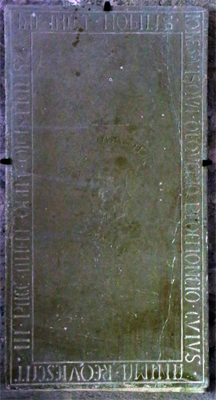 |
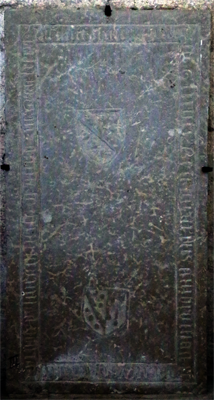 |
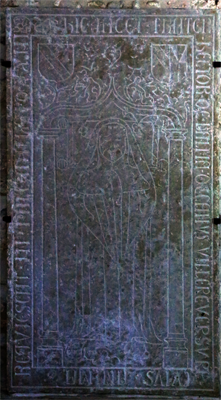 |
 |
| Jean
d'Ambronay, Cantor and Prior; also his brother,
Simon (1578) Latin inscription in border; Coat of arms at the base |
Pierre Favre
(1573) French text in border and face. Coat of arms above the latter |
Jean Visqua Latin inscription in border. In the centre there appears to be a shield of arms with an inscription on a scroll above; now almost obliterated | Possibly,
Amédée Guiot (1476) I cannot make out the text but this tomb is described as haing two shields of arms. |
Brother Hector de La
Balme Latin inscription. Incised figure under an arch. Two heraldic shields above |
French text on face. Pierre ? 1626 and his wife 1650 not listed |
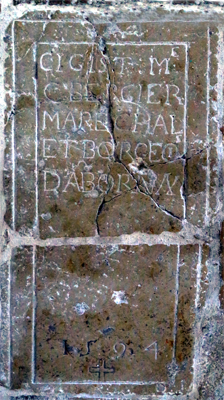 |
 |
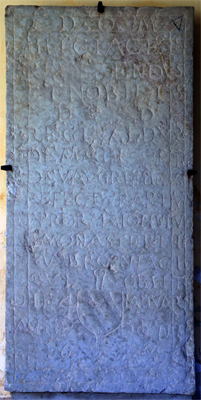 |
 |
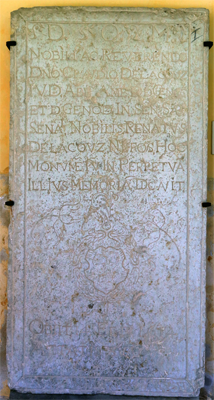 |
 |
| French inscription: 'M. C. Bergier Marechal et Borgeois' 1591. This slab is on the floor and the most legible. | Latin inscription, arms below | Renaud de
Malyvert de Vaugringeneuse (1678) Prior Latin inscription, arms near base. |
Text on border in Latin Incised effigy of Prior (1482) |
Claud de la
Couz (1614), Abbot Latin text Arms below |
Émerentienne de
Moyriac (1692) Widow of Bérnard de Breuil French text on face and in border. Armszsz |
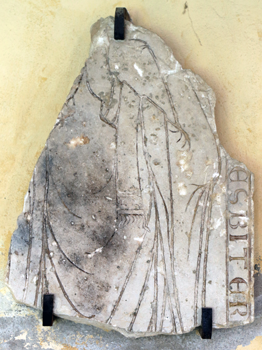 |
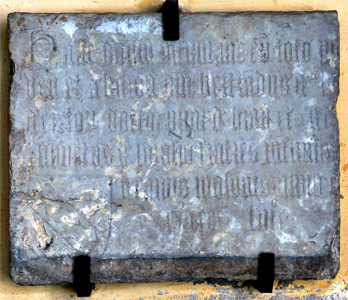 |
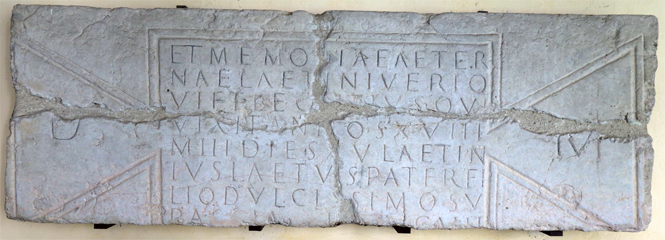 |
| Fragment: Incised figure of priest
Border text in Latin |
Fragment: Text only, Latin | Fragment: Text in Latin. Part of design |
| Please Note: The excellent and informative guide book lists the names of the abbots, officers and monks, bourgeois and artisans, and others, but unfortunately only prints one photograph. I have attempted to match photograph and text but may not always be as accurate as I should like as the text is difficult to read. |
| There is one other church in Ain
listed with a gisant. This is the Church of St
John the Baptist at Mionnay. Gisant of the tomb of
the Morel brothers. Inscription: 'Erected by Remond elder of the
three Morel Brothers, their cousins and well wishers'. Marble and
alabaster, 1844. I will try and visit this church in due course. |
Please note Ain is the only department in the Rhône-Alpes Region we have visited to date